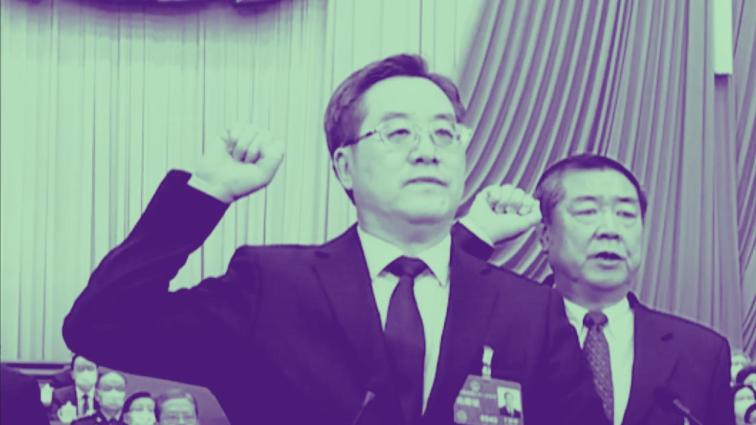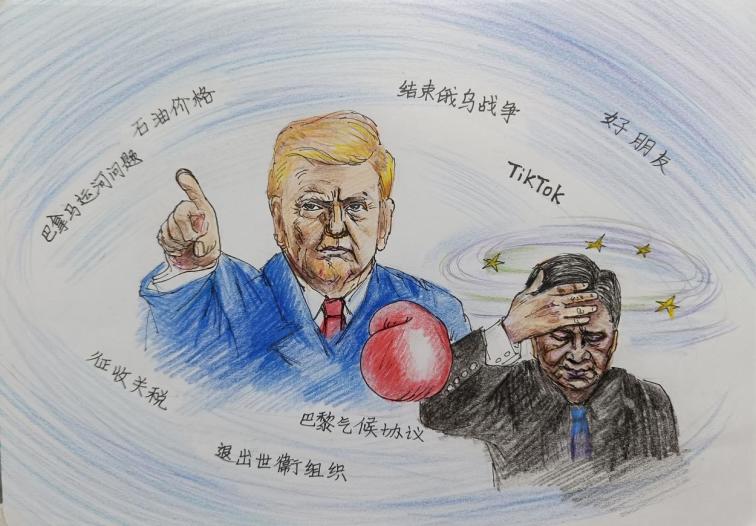Dark clouds hang over Tiananmen Square in Beijing. (Lintao Zhang/Getty Images)
[People News] The Chinese Communist Party's (CCP) top-level power struggle has reached a fever pitch, with internal divisions in Zhongnanhai becoming too apparent to conceal from the outside world. Analysts suggest that top officials are scheming against each other, and many harbour disloyal intentions toward Xi Jinping in this political struggle. The power pyramid of the CCP is showing cracks, and the leadership is fragmented.
The Central Politburo of the CCP is the second-highest decision-making body, subordinate only to the Politburo Standing Committee. By convention, Politburo members hold monthly meetings to discuss major domestic and international policies.
The 20th Central Committee Politburo consists of 24 members, considered to be Xi Jinping’s hand-picked team, now halfway through their term. Independent political commentator Du Zheng recently published an analysis in Shangbao, arguing that the balance of power within the Politburo has been disrupted, with infighting causing widespread disarray. Even those not purged are left in a miserable state, plotting against each other, creating an apocalyptic scene in Zhongnanhai.
Du Wen, a former deputy director of the Legal Advisory Office of Inner Mongolia’s Legal Affairs Department who is now in exile in Europe, analysed the current turmoil among the CCP's top leadership and the accumulation of abnormal developments from five perspectives in his program An Insider’s View of China.
First Indicator: Frequent Disappearance of the Leader — A Highly Unusual Signal in a Highly Centralised System
Since May 14, Xi Jinping has disappeared without explanation, then reappeared under strange circumstances, only to miss the BRICS summit — an event he had never skipped — while travelling instead to Yangquan, Shanxi. His repeated absences from key diplomatic and party events have triggered widespread speculation both domestically and abroad.
Du Wen states that in the CCP’s rigid political system — which emphasises absolute loyalty to a single leader — such unexplained absences are highly irregular. There’s no explanation, no appointed deputy, and no media coverage. This intentional void often signals power struggles or internal instability.
Second Indicator: Xi’s Loyal Generals Fall One by One — Central Nervous System Breakdown
From Central Military Commission (CMC) member Miao Hua being investigated, to Vice Chairman He Weidong vanishing, and a series of Xi’s appointees being purged — all signs indicate that the core of Xi’s military faction is collapsing.
Du Wen suggests that unless Xi himself is executing a purge to consolidate power, this could signal anti-Xi forces within the party systematically severing his support base, employing a gradual isolation strategy. Either explanation points to the same conclusion: the internal structure of power in Zhongnanhai is destabilising.
Third Indicator: Military Begins to Speak — Power Struggles Break the Silence
In December last year, the PLA’s official newspaper, PLA Daily, published four consecutive articles emphasising “intra-party democracy and collective leadership,” which appeared to challenge the “Chairman Responsibility System” — the hallmark of Xi’s absolute military control. These terms recall Deng Xiaoping-era political rhetoric.
Taiwan’s National Chengchi University researcher Song Guocheng commented that this is a clear sign of opposition to Xi Jinping under the banner of Deng, reflecting dissenting voices within the military.
Du Wen emphasised that these statements are not rumours or fringe voices but come from the military’s main mouthpiece, suggesting that parts of the CCP’s system are actively trying to decouple from Xi’s dictatorship over the military and rebuild collective legitimacy.
Between May 30 and June 8 this year, the PLA Daily ran eight front-page articles under the theme Clarifying Right and Wrong, written by different individuals on different subtopics. On the surface, they discuss the conduct of Party cadres, but in reality, they reflect deeper political critiques.
An article by Zhong Yuan of The Epoch Times pointed out that whether it’s the PLA’s eight-part editorial or the latest disciplinary regulations for party members, both indicate that massive power shifts are brewing within the CCP core — it’s just a matter of time before they come to light.
Fourth Indicator: Zhang Youxia’s High-Profile Appearance Signals Escalating Military Power Struggles. On July 7, Beijing held a ceremony commemorating the 88th anniversary of the nationwide resistance against Japan. Zhang Youxia’s prominent appearance raised eyebrows, signalling intensifying military infighting.
The downfall of two former defence ministers, Wei Fenghe and Li Shangfu, has threatened Zhang Youxia’s position. Some overseas analysts believe Zhang, in an act of self-preservation, struck back by taking down Miao Hua and He Weidong from Xi’s camp.
However, Du Wen disagrees. He argues that without Xi Jinping’s direct approval, Miao Hua would not have been purged — that’s basic political logic.
Still, Du Wen notes that on July 7, Zhang Youxia appeared in Beijing while Xi Jinping travelled alone to Shanxi for a memorial. This symbolic disconnect was likely a carefully choreographed show of power balance and internal restraint, revealing that the top-level power balance has been stretched to its limits.
Fifth Indicator: Post-Xi Jinping Era Speculation Surges — Political Climate Undergoes Dramatic Shift
Recently, online rumours have surged about a potential return of reformist factions: the re-emergence of Party elders’ influence, Zhang Youxia’s rising clout, and the comeback of “Tuanpai” leaders like Wang Yang and Hu Chunhua.
Du Wen states that while much of this may be speculation lacking rigorous logic, the mere fact that such discussions are spreading widely suggests Xi Jinping’s personal authority is no longer untouchable. His position as the “Supreme Leader” has visibly weakened.
Du Wen concludes that taken together, these five indicators paint a clear picture: the CCP’s power pyramid is quietly shaking. Cracks have formed, and although the ultimate direction is unclear, signs of crisis are already visible.
He emphasises that while it's premature to declare Xi has lost power, it is evident that top officials within the Party harbour disloyal thoughts. Under the pressure of economic turmoil, social unrest, and international isolation, the instability, tension, and fragility of the CCP’s top leadership are undoubtedly increasing.
If Xi continues to vanish in the coming weeks or more high-level officials are removed or reshuffled, speculation of an imminent power reshuffle will only intensify. As history shows, every unusual silence and misalignment within the CCP often signals a dramatic, quietly unfolding transformation.
Du Zheng’s article also noted that even if Xi hasn’t been formally removed, his authority — both within the Party and nationally — has been significantly weakened. The staged North Korea-style displays of public adoration during Xi’s local visits are orchestrated by local officials, and the only loyalty a dictator can command is false loyalty.
(First published by People News)











News magazine bootstrap themes!
I like this themes, fast loading and look profesional
Thank you Carlos!
You're welcome!
Please support me with give positive rating!
Yes Sure!